5 yen coin
The 5 yen coin (五円硬貨, Go-en kōka) is one denomination of Japanese yen. The current design was first minted in 1959 using Japanese characters known as the "new script", and were also minted from 1948–1958 using "old-script" Japanese characters. Five-yen coins date to 1870 (when, due to the much higher value of the yen, they were minted in gold). The modern-day coin was first produced in 1948 with a differently styled inscription. This was changed in 1959 and the design has remained unchanged since.
Japan | |
| Value | 5 Japanese yen |
|---|---|
| Mass | 3.75 g |
| Diameter | 22 mm |
| Center hole diameter | 5 mm |
| Composition | c. 65% Cu c. 35% Zn |
| Years of minting | 1870–present |
| Catalog number | KM 72, 72a, 96.1 and 96.2 |
| Obverse | |
 | |
| Design | Rice, water and gear |
| Design date | 1959 |
| Reverse | |
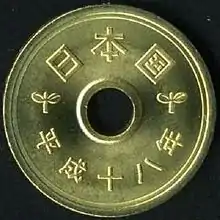 | |
| Design | Tree sprouts |
| Design date | 1959 |
The obverse of the coin depicts a rice plant growing out of the water, with "five yen" written in kanji; the reverse is stamped with "Japan" and the year of issue, also in kanji, separated by sprouts of a tree. The three graphic elements of the coin represent agriculture and fisheries, the key elements of the Japanese first-sector economy. Around the central hole, there is a gear that represents industry. It is the only Japanese coin in circulation to lack Hindu-Arabic numerals on either side.
History
Gold five yen (1870-1930)
Five yen coins were first struck in gold for the Japanese government in 1870 at the San Francisco Mint.[1] At the time a new mint was being established at Osaka, which did not receive the gold bullion needed for coinage until 1871.[2] The yen was officially adopted by the Meiji government in an act signed on June 27, 1871.[3] It remains unknown if any 1871 five yen coins were actually struck that year as official records have coinage beginning in 1872.[4][5] The first and second five yen coin designs feature a dragon figure on the obverse surrounded by legends, while the reverse features the emblem of the Imperial family.[lower-alpha 1] Each coin was struck in .900 fine gold with a weight of 8.3g, and a width of initially 23.8mm.[6] The diameter was later reduced to 21.8mm when the second design was introduced in 1872.[7] Five yen coins continued to be struck until uninterrupted until 1879, when for an unknown reason none were recorded as minted. Coinage resumed in 1880 and remained unchanged until 1897 when Japan officially went onto the gold standard.[8] During this time the gold five yen coin was given a third and final new design. The diameter was reduced from 21.8mm down to 16.9mm, and the weight was changed from 8.3 to 4.2 grams. Mintage amounts from 1898 until the end of Meiji's reign were low as compared to previous years. Five yen gold coins were last minted in 1930 to act as a reserve for gold certificates. None of these coins were in general use at the time as the medium of commerce consisted of 5 yen banknotes.[9]
Modern five yen (1948-)
Almost 20 years would pass before the Japanese government authorized the production of a new five yen coin. These new coins were first struck in 1948 and are made of a brass alloy consisting of 60 to 70% copper, and 30 to 40% zinc.[10][11] Using this type of alloy combination is now a remnant from when World War II era weapons were scrapped to produce the coins.[12] These coins feature a pigeon within a circle on one side and were only minted for two years. Two different varieties were made in 1949 which included the old pigeon type coins, and new coins featuring a hole in the center. These first holed five yen coins use an old style Japanese script known as Kaisho.[10] The Japanese government added the hole in the center of the coin to save material costs.[13] The overall design of the coin featuring rice, water and a gear on the obverse, and tree sprouts on the reverse has not changed since this time. The final design which is minted today uses a modern style script which was first added in 1959.[10] Five yen coins made headlines in 1999 in regards to the nuclear accident at Tokai, Ibaraki. Physicists Masuchika Kohno and Yoshinobu Koizumi showed how the coin could be used to estimate neutron dosage to the surrounding population, by measuring its zinc isotope ratios. They concluded that the coin could offer information about the total neutron effect during the accident. The coins could also give insight about shielding modern Japanese houses as the coins were recovered from indoors.[14] Very few five yen coins were minted between 2009 and 2013 making them premium coins for collectors as coins for the latter four years are confined to mint sets. This was due to an increase in the usage of electronic currency which inhibited demand for new coins.[15][16] Mintage figures recovered in 2014 and coins continue to be produced for circulation up to the present day.
Cultural significance
The Japanese for "five yen," go en (五円) is a homophone with go-en (御縁), "en" being a word for causal connection or relationship, and "go" being a respectful prefix. As a result, five-yen coins are commonly given as donations at Shinto shrines with the intention of establishing a good connection with the deity of the shrine, and is widely believed it is best to insert a single five-yen coin into a new wallet before inserting any other money.
Circulation figures
Meiji
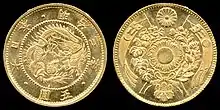
Design 1 - (1870–1871)

Design 2 - (1872–1897)
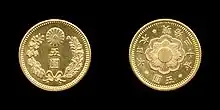
Design 3 - (1897–1930[lower-alpha 2])
The following are circulation figures for the coins that were minted between the 3rd, and the 45th and last year of Meiji's reign. Coins for this period all begin with the Japanese symbol 明治 (Meiji). One yen trade dollars and/or patterns are not included here.
- Inscriptions on Japanese coins from this period are read clockwise from right to left:
"Year" ← "Number representing year of reign" ← "Emperor's name" (Ex: 年 ← 五十三 ← 治明)
| Year of reign | Japanese date | Gregorian date | Mintage |
|---|---|---|---|
| 3rd | 三 | 1870 | 273,536[6] |
| 4th | 四 | 1871 | Unknown[6] |
| 5th | 五 | 1872 | 1,057,628[7] |
| 6th | 六 | 1873 | 3,148,925[7] |
| 7th | 七 | 1874 | 728,082[7] |
| 8th | 八 | 1875 | 181,728[7] |
| 9th | 九 | 1876 | 146,226[7] |
| 10th | 十 | 1877 | 136,271[7] |
| 11th | 一十 | 1878 | 101,198[7] |
| 13th | 三十 | 1880 | 78,704[7] |
| 14th | 四十 | 1881 | 149,249[7] |
| 15th | 五十 | 1882 | 113,015[7] |
| 16th | 六十 | 1883 | 108,746[7] |
| 17th | 七十 | 1884 | 113,768[7] |
| 18th | 八十 | 1885 | 200,607[7] |
| 19th | 九十 | 1886 | 179,849[7] |
| 20th | 十二 | 1887 | 179,303[7] |
| 21st | 一十二 | 1888 | 165,794[7] |
| 22nd | 二十二 | 1889 | 353,914[7] |
| 23rd | 三十二 | 1890 | 238,076[7] |
| 24th | 四十二 | 1891 | 216,089[7] |
| 25th | 五十二 | 1892 | 263,103[7] |
| 26th | 六十二 | 1893 | 260,424[7] |
| 27th | 七十二 | 1894 | 314,337[7] |
| 28th | 八十二 | 1895 | 320,090[7] |
| 29th | 九十二 | 1896 | 224,325[7] |
| 30th | 十三 | 1897 (Type 1) | 107,352[7] |
| 30th | 十三 | 1897 (Type 2)[lower-alpha 3] | 111,776[17] |
| 31st | 一十三 | 1898 | 55,888[17] |
| 36th | 六十三 | 1903 | 21,956[17] |
| 44th | 四十四 | 1911 | 59,880[17] |
| 45th | 五十四 | 1912 | 59,880[17] |
Taishō
The following are circulation figures for the coins that were minted during the 2nd and 13th year of Taishō's reign. Coins from this period all begin with the Japanese symbol 大正 (Taishō).
- Inscriptions on Japanese coins from this period are read clockwise from right to left:
- "Year" ← "Number representing year of reign" ← "Emperor's name" (Ex: 年 ← 三十 ← 正大)
| Year of reign | Japanese date | Gregorian date | Mintage |
|---|---|---|---|
| 2nd | 二 | 1913 | 89,820[18] |
| 13th | 三十 | 1924 | 76,037[18] |
Shōwa
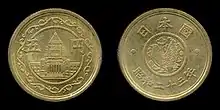
Design 1 - (1948–1949)
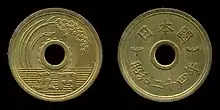
Design 2 - (1949–1958)
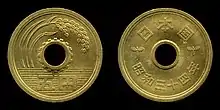
Design 3 - (1959–present)
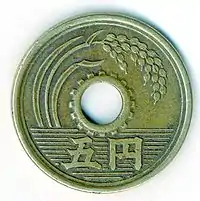
(Pre-1959)
The following are circulation dates which cover Emperor Hirohito's reign. The dates below correspond with the 23rd to the 64th year (last) of his reign. All five yen coins that were made before 1959 use kyūjitai, or old script Japanese. In 1949 only, two different styles of writing were used before a more modern one was established in 1950. This second style of writing was used until 1958 when the current script of Japanese took its place in the following year. Coins for this period will all begin with the Japanese symbol 昭和 (Shōwa).
- Japanese coins are read with a left to right format:
- "Emperor's name" → "Number representing year of reign" → "Year" (Ex: 昭和 → 四十八 → 年).
| Year of reign | Japanese date | Gregorian date | Mintage[19][20][lower-alpha 4] |
|---|---|---|---|
| 5th | 五 | 1930 (Gold) | 852,563[lower-alpha 5] |
| 23rd | 二十三 | 1948 | 74,520,000 |
| 24th | 二十四 | 1949 (Type 1) | 179,692,000 |
| 24th | 二十四 | 1949 (Type 2)[lower-alpha 6] | 111,896,000 |
| 25th | 二十五 | 1950 | 181,824,000 |
| 26th | 二十六 | 1951 | 197,980,000 |
| 27th | 二十七 | 1952 | 55,000,000 |
| 28th | 二十八 | 1953 | 45,000,000 |
| 32nd | 三十二 | 1957 | 10,000,000 |
| 33rd | 三十三 | 1958 (Old script) | 50,000,000 |
| 34th | 三十四 | 1959 (New script) | 33,000,000 |
| 35th | 三十五 | 1960 | 34,800,000 |
| 36th | 三十六 | 1961 | 61,000,000 |
| 37th | 三十七 | 1962 | 126,700,000 |
| 38th | 三十八 | 1963 | 171,800,000 |
| 39th | 三十九 | 1964 | 379,700,000 |
| 40th | 四十 | 1965 | 384,200,000 |
| 41st | 四十一 | 1966 | 163,100,000 |
| 42nd | 四十二 | 1967 | 26,000,000 |
| 43rd | 四十三 | 1968 | 114,000,000 |
| 44th | 四十四 | 1969 | 240,000,000 |
| 45th | 四十五 | 1970 | 340,000,000 |
| 46th | 四十六 | 1971 | 362,050,000 |
| 47th | 四十七 | 1972 | 562,950,000 |
| 48th | 四十八 | 1973 | 745,000,000 |
| 49th | 四十九 | 1974 | 950,000,000 |
| 50th | 五十 | 1975 | 970,000,000 |
| 51st | 五十一 | 1976 | 200,000,000 |
| 52nd | 五十二 | 1977 | 340,000,000 |
| 53rd | 五十三 | 1978 | 318,000,000 |
| 54th | 五十四 | 1979 | 317,000,000 |
| 55th | 五十五 | 1980 | 385,000,000 |
| 56th | 五十六 | 1981 | 95,000,000 |
| 57th | 五十七 | 1982 | 455,000,000 |
| 58th | 五十八 | 1983 | 410,000,000 |
| 59th | 五十九 | 1984 | 202,850,000 |
| 60th | 六十 | 1985 | 153,150,000 |
| 61st | 六十一 | 1986 | 113,960,000 |
| 62nd | 六十二 | 1987 | 631,775,000 |
| 63rd | 六十三 | 1988 | 396,120,000 |
| 64th | 六十四 | 1989 | 67,332,000 |
Heisei
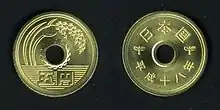
The following are circulation dates during the reign of Emperor Akihito (Heisei), who reigned from 1989 until his abdication in April 2019. The first year of his reign is marked with a 元 symbol on the coin as a one year type. Coins for this period all begin with the kanji characters 平成 (Heisei). Five-yen coins dated between 2010 and 2013 were only released in mint sets.
- Japanese coins are read with a left to right format:
- "Emperors name" → "Number representing year of reign" → "Year" (Ex: 平成 → 二十六 → 年).
| Year of reign | Japanese date | Gregorian date | Mintage [19][lower-alpha 4] |
|---|---|---|---|
| 1st | 元 | 1989 | 960,660,000 |
| 2nd | 二 | 1990 | 520,953,000 |
| 3rd | 三 | 1991 | 517,120,000 |
| 4th | 四 | 1992 | 301,130,000 |
| 5th | 五 | 1993 | 413,240,000 |
| 6th | 六 | 1994 | 197,767,000 |
| 7th | 七 | 1995 | 351,874,000 |
| 8th | 八 | 1996 | 207,213,000 |
| 9th | 九 | 1997 | 239,086,000 |
| 10th | 十 | 1998 | 172,612,000 |
| 11th | 十一 | 1999 | 60,120,000 |
| 12th | 十二 | 2000 | 9,030,000 |
| 13th | 十三 | 2001 | 78,025,000 |
| 14th | 十四 | 2002 | 143,662,000 |
| 15th | 十五 | 2003 | 102,406,000 |
| 16th | 十六 | 2004 | 70,903,000 |
| 17th | 十七 | 2005 | 16,029,000 |
| 18th | 十八 | 2006 | 9,594,000 |
| 19th | 十九 | 2007 | 9,904,000 |
| 20th | 二十 | 2008 | 9,811,000 |
| 21st | 二十一 | 2009 | 4,003,000 |
| 22nd | 二十二 | 2010 | 510,000[lower-alpha 7] |
| 23rd | 二十三 | 2011 | 456,000[lower-alpha 7] |
| 24th | 二十四 | 2012 | 659,000[lower-alpha 7] |
| 25th | 二十五 | 2013 | 554,000[lower-alpha 7] |
| 26th | 二十六 | 2014 | 87,538,000 |
| 27th | 二十七 | 2015 | 105,004,000 |
| 28th | 二十八 | 2016 | 35,064,000 |
| 29th | 二十九 | 2017 | 33,927,000 |
| 30th | 三十 | 2018 | 17,960,000 |
| 31st | 三十一 | 2019 | 16,946,000 |
Reiwa
The following are circulation dates in the reign of the current Emperor. Naruhito's accession to the Crysanthemum Throne took place on May 1, 2019 and he was formally enthroned on October 22, 2019. Coins for this period all begin with the Japanese symbol 令和 (Reiwa). The inaugural year coin (2019) was marked 元 (first) and debuted during the summer of that year.[21]
| Year of reign | Japanese date | Gregorian date | Mintage[19][lower-alpha 4] |
|---|---|---|---|
| 1st | 元 | 2019 | 20,574,000 |
| 2nd | 二 | 2020 | TBD |
Notes
- In numismatic terminology, a "legend" is a formal inscription found around the margin of a coin.
- The third and final gold coin design was also used during Taishō, and Shōwa's reign.
- Two coin designs were made in 1897, the second type is smaller as the weight was changed from 8.3 to 4.2 grams
- Mintages on the Japan Mint website are in thousands
- These coins were not in general use.[9]
- Two coin designs were made in 1949, the second type resembles the current one in use today.
- Not circulated.[19]
References
- Edouard Frossard (1878). The Coin Collector's Journal. 3. Scott and Company. p. 40.
- Annual Report of the Director of the United States Mint. United States Mint. 1895. p. 368.
- A. Piatt Andrew, Quarterly Journal of Economics, "The End of the Mexican Dollar", 18:3:321–356, 1904, p. 345
- United States House of Representatives (1876). Commercial Relations. House Documents. 15, Volume 284. U.S. Government Printing Office. p. 1092.
- Edouard Frossard (1878). The Coin Collector's Journal. 3. Scott and Company. p. 40.
and possibly some were struck in 1871, meiji 4, but we have not been able to find any bearing this date.
- "Japan 5 Yen Y# 11". Numismatic Guaranty Corporation. Retrieved March 26, 2019.
- "Japan 5 Yen Y# 11a". Numismatic Guaranty Corporation. Retrieved March 26, 2019.
- New Coinage law of Japan. Sound Currency. Sound Currency Committee of the Reform Club. 1899. p. 28 & 29.
- M. Epstein (1932). The Statesman's Year-Book. Springer. p. 1074. ISBN 9780230270619.
- "Current Coins list". Ministry of Finance (Japan). Retrieved August 17, 2020.
- Annual Report of the Director of the Mint. Department of the Treasury. 1949. p. 82.
- Currency of Japan -Guidance for Collection-. Japan Coin and Merchants Cooperative. 2010. pp. 184–186.
- Yoichi Hirakawa (2013). 500 Common Senses That No One Can Ask Anymore. Kosaido Bunko. p. 194. ISBN 978-4331653395.
- Kohno, Masuchika; and Yoshinobu Koizumi (2000). "Tokaimura accident: Neutron dose estimates from 5-yen coins". Nature. 406 (6797): 693. doi:10.1038/35021138. PMID 10963586. S2CID 4424321.
- "プレミア硬貨の価値!種類・査定額・オススメの買取業者をご紹介". Kosenkaitori (in Japanese). Retrieved August 17, 2020.
- "【あなたも持ってる?】令和でさらに高騰しそうなプレミア硬貨!". dogatch.jp (in Japanese). Retrieved August 17, 2020.
- "Japan 5 Yen Y# 32". Numismatic Guaranty Corporation. Retrieved March 26, 2019.
- "Japan 5 Yen Y# 39". Numismatic Guaranty Corporation. Retrieved April 11, 2020.
- "年銘別貨幣製造枚数" (PDF) (in Japanese). Japan Mint. Retrieved April 4, 2020.
- "Japan 5 Yen Y# 51". Numismatic Guaranty Corporation. Retrieved March 26, 2019.
- "Reiwa coins to debut summer 2019".
External links
| Wikimedia Commons has media related to 5 yen coins. |
- Circulating coin list -Japan Mint.
- Five yen coins from 1948 to 1958 - Bank of Japan (in Japanese)